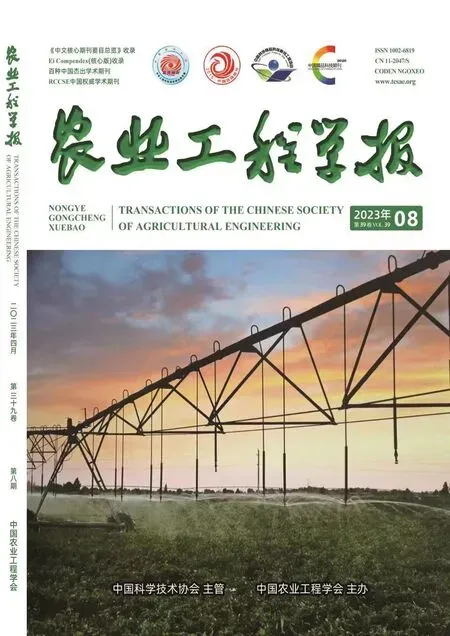考虑非一致性的黄土高原区旱涝复合事件的演变特征及其动态变化
高月娇,黄生志,王韩叶,王志霞,郭雯雯,穆振侠,陈 刚,黄 强
考虑非一致性的黄土高原区旱涝复合事件的演变特征及其动态变化
高月娇1,黄生志1※,王韩叶2,王志霞1,郭雯雯1,穆振侠3,陈 刚2,黄 强1
(1. 西安理工大学 西北旱区生态水利国家重点实验室,西安 710048;2. 云南省水利水电勘测设计院,昆明 650021;3. 新疆农业大学水利与土木工程学院,乌鲁木齐 830052)
受气候变化和人类活动的双重影响,传统水文序列的一致性假设受到破坏,在考虑非一致性的条件下探究相邻季节间旱涝复合事件的动态变化及主导因子,对区域的粮食安全与旱涝灾害防御意义重大。为探究非一致性条件下旱涝复合事件的动态演变特征及其主导因子,该研究以黄土高原为研究对象,基于广义可加模型拟合单季节标准化降水指数的边缘分布,构建二维Copula模型分析旱涝复合事件(中、重和极端情景下)的发生概率,并利用变量投影重要性准则探究复合事件动态变化的主导因子。结果表明:1)1982—2015年间正常转旱、旱转正常、正常转涝和涝转正常事件分布广泛且发生频次较高(高于22次);2)春-夏内蒙古持续干旱、夏-秋青海持续干旱、秋-冬宁夏持续干旱、冬-春山西持续干旱、夏-秋陕西持续洪涝、夏-秋甘肃持续洪涝事件的发生概率较大;3)春-夏由旱转涝、夏-秋持续洪涝、秋-冬由涝转旱、秋-冬持续干旱和冬-春季持续干旱事件的发生概率显著上升,对该区域社会经济与生态将产生不利影响;4)复合事件发生概率动态变化的主导因素为北极涛动指数和太阳黑子指数。研究成果将为黄土高原地区旱涝复合事件的精准防御提供科技支撑。
干旱;洪涝;模型;旱涝复合事件;非一致性;动态变化;黄土高原
0 引 言
全球持续变暖改变了气候系统的热力环境,影响了全球的水循环过程,进而导致极端事件频发[1]。干旱和洪涝是较典型的极端事件[2],具有影响范围广、发生频率高的特点,易对生态环境、粮食产量和社会生产活动产生不利影响。干旱和洪涝灾害在全世界的发生频率增加,强度加大[3],每年造成的经济损失分别超过80亿美元和300亿美元。虽然干旱和洪涝灾害几乎不会同时发生,但有时空相关性的灾害会相互作用发展成为旱涝复合型灾害[4-5],从而增加灾害的影响范围和影响强度,造成更严重的损失,例如澳大利亚、英国和秘鲁等国发生的由旱转涝灾害均对经济、环境和粮食安全造成严重影响[6-8]。
在全球变暖的背景下,季节间持续干旱(洪涝)和季节性旱涝交替等现象更加频繁[9],其带来的负面影响呈现出多维和多层次性的特点[10]。相邻季节间正常转旱、旱转正常、正常转涝、涝转正常、持续干旱、持续洪涝、由旱转涝和由涝转旱事件统称为旱涝复合事件[11],其中,持续干旱(洪涝)事件不仅对工农业生产、粮食安全和生态系统产生严重的负面影响[11-13],更会进一步加剧灾害的影响时间、加大灾害的破坏程度[14];而旱涝交替现象是干旱和洪涝灾害在短时间内的快速转变过程[15],具有突变性的特点,可能会引发湖泊干涸、城市缺水、泥石流和山洪灾害频发等一系列问题[16-17]。有研究表明,连续旱涝灾害在未来可能成为一种常见的现象[18]。
国外主要侧重于单一干旱和洪涝灾害的研究[19-20],而对旱涝复合事件的研究较少,如:HE等[21]发现全球约5.9%和7.6%的陆地分别发生了春-夏和秋-冬季由旱转涝事件;MARENGO等[22]发现“拉尼娜”现象是南美洲发生旱涝急转现象的主要原因;ESPINOZA等[23]发现亚马逊流域的由旱转涝事件主要受厄尔尼诺现象的影响。国内对旱涝组合事件的研究主要集中在旱涝交替现象,其研究的时间尺度集中在夏季或汛期[24],研究内容涵盖旱涝急转事件的成因、演变规律、预测、应对方法和对农业的影响等[24-26]。持续干旱(洪涝)事件也开展了部分研究,例如:张冬冬等[27]研究云南省季节连旱的概率特征,发现云南北部在春-夏、夏-秋和冬-春季发生持续干旱事件的概率较大;刘宇峰等[28]发现黄土高原的持续干旱事件增多;SHI等[29]发现黄河流域春-夏和夏-秋季倾向于发生持续干旱(持续洪涝)事件;杨志勇等[10]发现滦河流域在夏-秋季易发生旱涝复合事件。
综上所述,以往研究虽涉及单一旱灾、单一涝灾、旱涝交替现象和持续干旱(洪涝)事件,但未系统揭示相邻季节间旱涝复合事件的演变机理,尚不明确旱涝复合事件的驱动因子;此外,以往研究均在一致性的条件下基于气象站点数据分析旱涝复合事件的演变特征,忽略了气候变化的影响和小地理尺度上的水文变化特征。因此,本文以旱涝灾害频发的黄土高原为研究对象,在考虑非一致性的条件下,基于高精度的格点数据开展相邻季节间旱涝复合事件演变特征与影响因子研究,以期为黄土高原旱涝复合灾害的精准防御提供科学依据。
1 数据与方法
1.1 研究区概况
黄土高原(图1)位于黄河中上游地区,东起太行山,西至乌鞘岭,南连秦岭,北抵长城,是中国北方与西北地区的交界处。流域总面积为6.2×105km2,地处34˚41'~41˚16'N,100˚52'~114˚33'E,横跨中国7个省份(包括山西、陕西、甘肃、内蒙古、宁夏、青海和河南)。流域属于大陆性季风气候区,区域内降水年际变化大,年内分布不均匀,降水主要发生在夏季,多年平均降雨量为466 mm,自东南向西北递减,具有明显的梯度变化特征;多年平均气温在-4.0~13.0℃之间,由北到南逐渐升高。
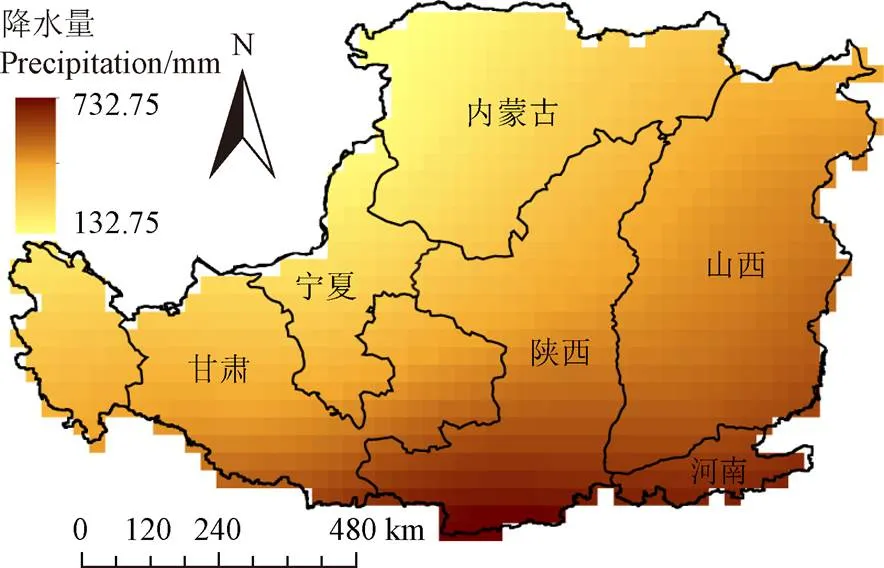
图1 黄土高原分区及多年平均降水量示意图
1.2 数据来源
黄土高原气象数据来自全球陆地数据同化系统生成的(GLDAS-Noah)降水产品(https://search.earthdata. nasa.gov/search?q=GLDAS/),研究所用的时间范围从1981年到2015年,以月为时间尺度,空间分辨率为0.25°×0.25°,由于选取的GLDAS-V2.0时间仅到2014年,故本文用GLDAS-V2.1降水资料补齐2015年的降水数据[30]。此外,研究所用数据还有同期大气环流因子,包括太阳黑子指数(Sunspots)、厄尔尼诺南方涛动指数(El Niño-Southern Oscillation,ENSO3.4)、北极涛动指数(Arctic Oscillation,AO)和太平洋十年涛动指数(Pacific Decadal Oscillation,PDO),其中,Sunspots来自比利时皇家天文台(http://sidc.oma.be/silso/dayssplot);ENSO3.4、AO和PDO均来自NOAA地球系统研究实验室(https://www.esrl.noaa.gov/psd/data/climateindices/list/)。
1.3 研究方法
1.3.1 旱涝等级的划分
目前,国内常用的旱涝指标包括降水距平百分率、Z指数、标准化降水蒸散指数和标准化降水指数(standardized precipitation index,SPI)等[31-33]。SPI指数具有计算简单、多时间尺度和稳定性好等特点,故本文选取SPI指数作为季尺度旱涝等级划分的依据,同时参照国家规范GB/T 20481—2017《气象干旱等级》,最终确定的旱涝等级划分标准见表1。
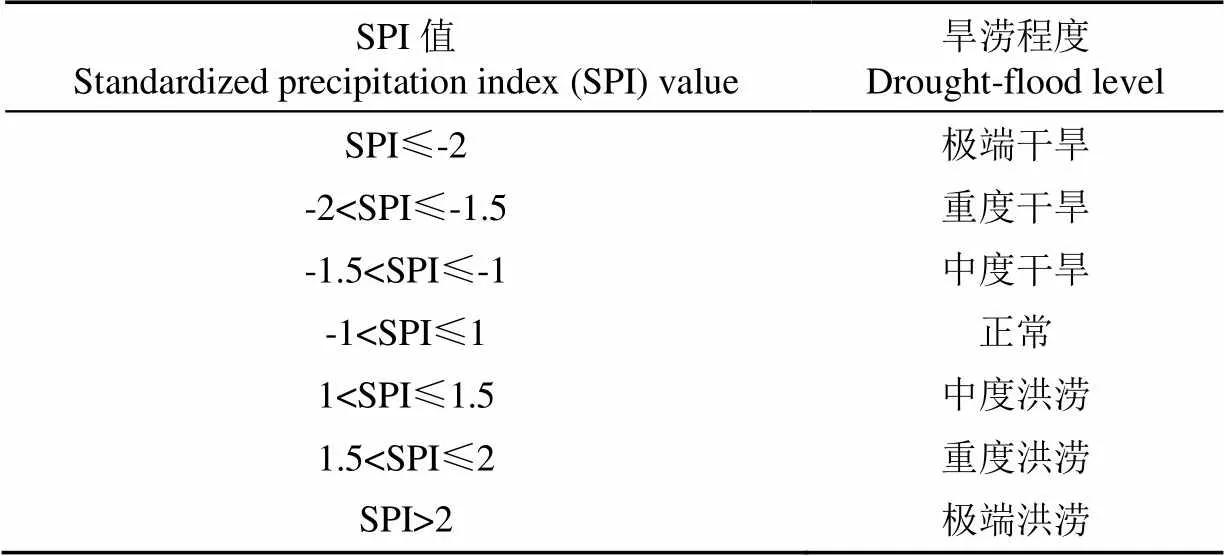
表1 旱涝等级划分标准
1.3.2 非一致性检验
水文序列非一致性检验包括趋势、周期和突变检验。检验方法包括Mann-Kendall(M-K)检验法、双累积曲线法、有序聚类法和Pettitt检验法等[34-35]。本文用M-K检验单季节SPI序列的变化趋势,同时采用Pettitt检验法分析其突变情况,具体计算过程可参考文献[35]。其中,当<0.05时,序列存在有效突变点,说明序列的一致性遭到破坏,需要在非一致性的条件下进行频率分析。
1.3.3 GAMLSS模型
GAMLSS(generalized additive models for location,scale and shape)模型最早由RIGBY和STASINOPOULOS[36]于2005年提出,是一种基于位置、尺度和形状的半参数广义可加模型。该模型是时变矩模型的进一步发展,能够灵活地描述统计参数与解释变量之间的关系,且比时变矩法更便捷,极大地方便了非一致性分析工作[37-39],目前已广泛用于经济学、医学和水文研究等领域[40]。因此,本文基于该模型拟合单季节SPI序列的非一致性边缘分布,并在此基础上探究旱涝复合事件的演变特征。
模型内含有诸多分布函数,但由于SPI在计算过程中已经标准化,同时考虑SPI序列的取值范围,本文仅考虑用正态分布进行拟合。同时,选择幂次函数(bfp)和三次样条函数(cs)作为参数和解释变量之间的连接函数,考虑到幂次函数的幂与三次样条函数的自由度过高会存在过度拟合现象,故本文仅选取bfp(t,1)、bfp(t,2)、bfp(t,3)、cs(t,0)、cs(t,1)、cs(t,2)及cs(t,3)进行模型连接。
1.3.4 Copula函数
Copula函数能够有效刻画变量间的相依性,同时能够灵活构造多变量联合分布,目前已广泛应用于干旱、洪水、泥沙等水文事件的研究中[41-42]。因此,本研究利用该函数构造非一致性/一致性条件下的二维联合分布模型,定量描述旱涝复合事件的发生概率。
本文依据表1定义了中度、重度和极端情景。为计算不同情景下复合事件的发生概率(表2),参照文献[43-44]推导出由旱转涝、由涝转旱、持续干旱、持续洪涝、正常转旱、旱转正常、正常转涝、涝转正常事件的发生概率计算式分别如下(以中度情景为例):








表2 不同情景下复合事件的发生概率
注:复合事件表示当季出现一种降水情形的条件下,后季出现不同或相似的降水情形,例如由旱转涝表示当季发生干旱而后季则发生洪涝。
Note: Compound events mean that under the condition of one precipitation situation in the current season, different or similar precipitation situations occur in the later season. For example, the change from drought to waterlogging means that drought occurs in the current season and then floods occur in the next season.
1.3.5 变量投影重要性准则
变量投影重要性准则(variable importance in projection,VIP)指自变量对因变量影响的重要程度。若自变量的VIP值大于1,表明自变量对因变量的影响较为重要;若VIP值介于0.5~1,表明重要性一般;若VIP值小于0.5,则表明自变量对因变量基本没有影响,具体计算过程可参考文献[45]。本文用VIP准则来反映大气环流因子对旱涝复合事件动态变化的影响情况,并选择VIP值解释度最大的因子为复合事件动态变化的主导因子。
2 结果与分析
2.1 相邻季节间复合事件的时空分布特征
季节按常规划分为:春-夏(3—8月)、夏-秋(6—11月)、秋-冬(9—2月)和冬-春季(12—5月)。依据表 2统计各像元在不同情景下黄土高原复合事件的发生频次。计算相邻季节间各像元的平均发生次数,发现秋-冬季最易发生旱涝复合事件,发生次数为28.88次,随后依次是冬-春季(27.40次)和夏-秋季(26.42次)春-夏季发生旱涝复合事件的频次较少,为25.05次,(图 2a)。计算各像元由旱转涝、由涝转旱、持续干旱、持续洪涝、正常转旱、旱转正常、正常转涝和涝转正常事件的平均发生频次,发现正常转旱、旱转正常、正常转涝和涝转正常事件的频次较高,分别为22.15、22.83、22.81和22.42次;此外,就持续性旱涝事件与旱涝交替现象而言,持续干旱事件的发生频次最高,为5.46次,其次为持续洪涝事件(4.70)和由涝转旱事件(3.97次),最后为由旱转涝事件(图 2b)。
空间上,由旱转涝易发生在陕西与山西地区,由涝转旱事件主要发生在山西地区,持续干旱与持续洪涝事件则易发生在内蒙古地区,而正常转旱、旱转正常、正常转涝与涝转正常事件则广泛分布在整个流域上。
2.2 单季节SPI序列的非一致性检验
用M-K检验法分析黄土高原地区各季节SPI序列的变化趋势,由图3可知:流域大部分地区春季和冬季SPI呈下降趋势,表明春季和冬季的降水减少,干旱化趋势突出;而夏季与秋季SPI呈上升趋势,表明夏季与秋季的降水增多,湿润化趋势突出。
采用Pettitt检验法探究单季节SPI序列的突变情况,发现流域内春季的SPI序列未发生突变,夏、秋和冬季的SPI序列均发生突变,其突变的发生区域分别在青海、山西北部和甘肃东部地区。
2.3 旱涝复合事件的演变特征及其主导因子
2.3.1 边缘分布与联合分布
由于SPI在计算过程中已经标准化,同时考虑SPI序列的取值范围,本文仅用正态分布拟合单季节SPI序列的边缘分布。若单季节SPI序列发生突变,基于GAMLSS模型拟合该季节SPI序列的边缘分布,同时利用赤池信息准则(akaike information criterion,AIC)与贝叶斯信息准则(schwarz bayesian criterion,SBC)筛选出最优连接方式,得出对应的位置参数和尺度参数,并基于此得到该SPI序列的最优边缘分布;若SPI序列不发生突变,则在一致性条件下用正态分布拟合得出最优边缘分布。
用均方根误差(root mean square error,RMSE)和AIC准则从Clayton-Copula、Frank-Copula、Gumbel- Copula、Gaussian-Copula和t-Copula函数中选取相邻季节间SPI序列的最优Copula函数。

图3 单季节标准化降水指数的变化趋势
2.3.2 旱涝复合事件的发生概率
根据优选出的Copula函数及其对应的相关参数,计算中度、重度和极端情景下相邻季节间旱涝复合事件的发生概率、动态变化和主导因子,由于在中度、重度和极端情景下相邻季节间旱涝复合事件的演变特征基本一致,因此以中度情景为例进行分析,下同。
时间上:春-夏季易发生正常转涝和涝转正常事件,发生概率均为11%;夏-秋季和冬-春季易发生正常转旱(旱转正常)事件,其发生概率分别为16%和15%;而秋-冬季易发生正常转旱和正常转涝事件。
空间上:正常转旱、旱转正常、正常转涝和涝转正常事件在流域上广泛分布;就持续性旱涝事件与旱涝交替现象而言,内蒙古地区易在春-夏季发生持续干旱事件,山西北部与河南地区易发生冬-春季持续干旱事件,宁夏地易发生秋-冬季持续干旱事件,青海地区易发生夏-秋季持续干旱事件,陕西南部与甘肃地区分别易在夏-秋季与秋-冬季发生持续洪涝事件(图4)。此外,持续干旱(洪涝)事件的发生概率比旱涝交替事件(由旱转涝、由涝转旱事件)大,与2.1节的频次统计结果一致,可以相互印证结果的合理性。
2.3.3 旱涝复合事件的动态变化
探究旱涝复合事件的动态变化特征,可以为预防旱涝复合事件的发生提供一定依据。本节以5 a时间序列为滑动窗口[46]探究复合事件发生概率的变化趋势,并用M-K趋势法进一步分析复合事件发生概率的非参数变化趋势。由图5可知:流域内大部分地区的春-夏由旱转涝、春-夏正常转涝、夏-秋持续洪涝、夏-秋正常转旱、夏-秋旱转正常、秋-冬由涝转旱、秋-冬持续干旱、秋-冬正常转涝、秋-冬涝转正常、冬-春持续干旱、冬-春正常转旱与冬-春正常转涝事件的发生概率普遍呈上升趋势;而春-夏由涝转旱、春-夏正常转旱、夏-秋由旱转涝、夏-秋正常转涝、秋-冬由旱转涝、秋-冬旱转正常、冬-春持续洪涝和冬-春涝转正常事件的发生概率则呈下降趋势。
发生概率较大的旱涝复合事件中,春-夏内蒙古持续干旱、秋-冬宁夏持续干旱、冬-春山西持续干旱、夏-秋陕西持续洪涝与夏-秋甘肃持续洪涝事件均呈上升的趋势,而夏-秋青海持续干旱事件则呈下降趋势。频繁发生的正常转旱、旱转正常、正常转涝和涝转正常事件中,除春-夏正常转旱、秋-冬旱转正常、夏-秋正常转涝与冬-春涝转正常事件呈下降趋势外,其余复合事件均普遍上升。
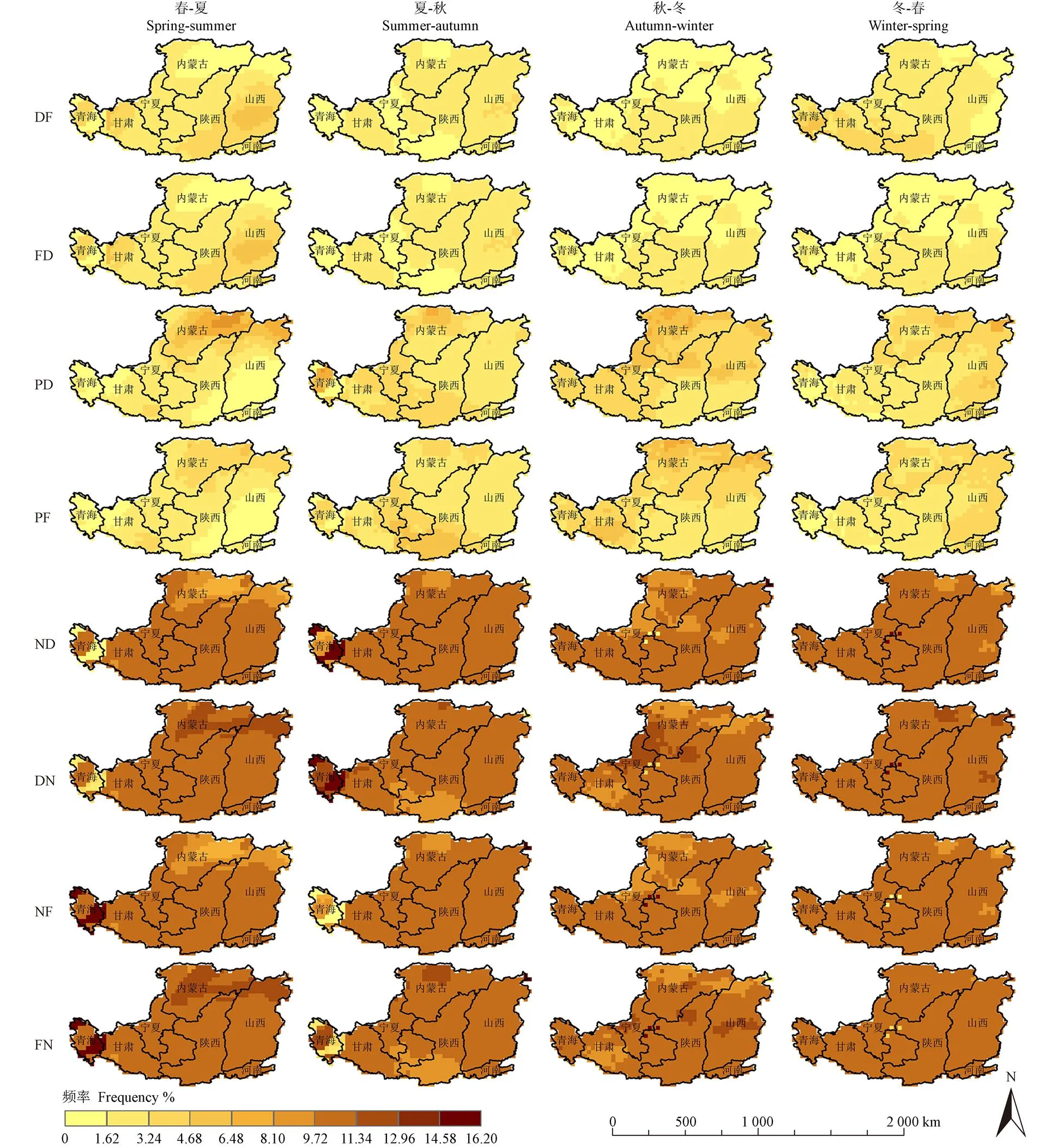
图4 中度情景下复合事件的发生概率
2.3.4 旱涝复合事件动态演变的主导因素
大量研究表明,复合事件与大气环流异常密切相关[47]。为了进一步揭示变化环境下旱涝复合事件动态变化的主导因子,本节用VIP准则分析各大气环流因子对复合事件动态变化的影响情况,基于此得到旱涝复合事件动态演变的主导因素。
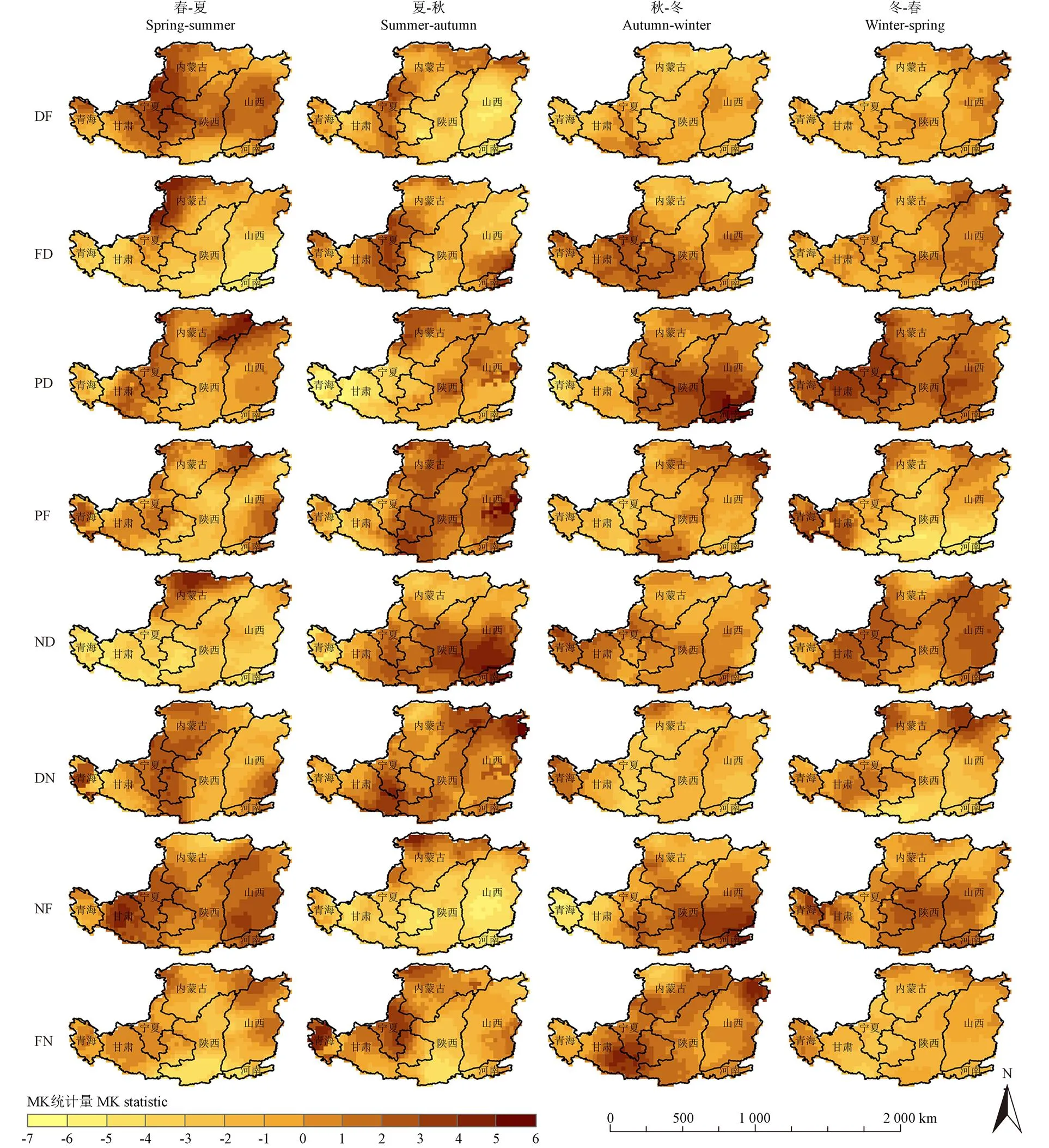
图5 中度情景下旱涝复合事件发生概率的MK趋势检验图
由图6可知:流域内呈上升趋势的复合事件中,夏-秋持续洪涝、夏-秋正常转旱和秋-冬持续干旱事件主要由北极涛动(AO)主导,秋-冬正常转涝、秋-冬涝转正常、冬-春持续干旱和冬-春正常转旱事件主要受太阳黑子(Sunspots)的影响,春-夏由旱转涝、春-夏正常转涝、夏-秋旱转正常和冬-春正常转涝事件则由Sunspots与AO共同主导;呈下降趋势的复合事件中,春-夏由涝转旱、春-夏正常转旱和夏-秋由旱转涝事件主要受AO的影响,秋-冬旱转正常、冬-春持续洪涝和冬-春涝转正常事件由Sunspots主导,而夏-秋正常转涝和秋-冬由旱转涝事件则主要受Sunspots与AO的影响。此外,发生概率较大的春-夏内蒙古持续干旱事件由Sunspots主导,秋-冬宁夏持续干旱、夏-秋陕西持续洪涝、夏-秋甘肃持续洪涝、夏-秋青海持续干旱事件主要由AO主导,而冬-春山西持续干旱事件则由Sunspots与AO共同主导。
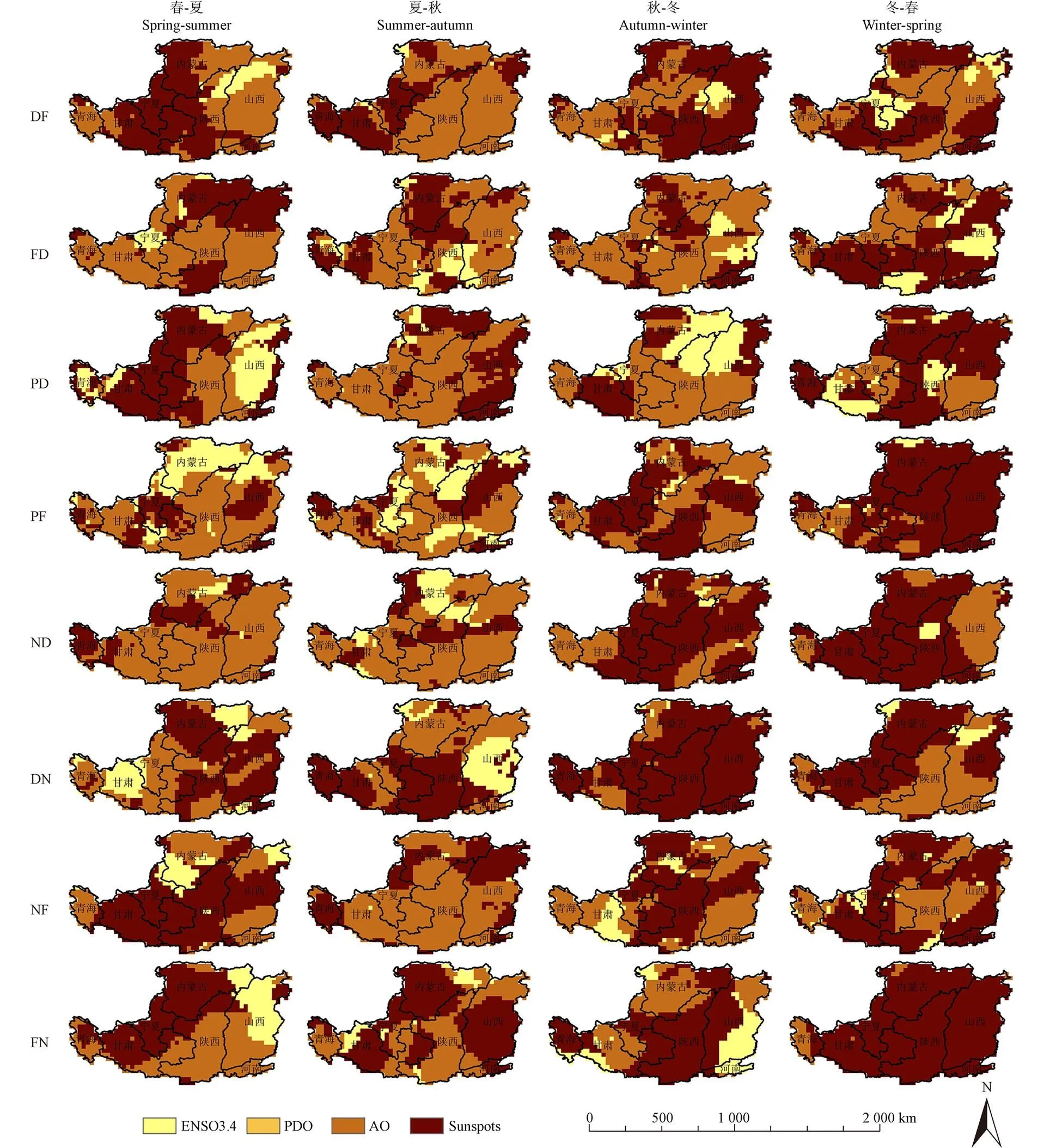
注:ENSO3.4、AO、 PDO、Sunspots分别为厄尔尼诺南方涛动指数、北极涛动指数、太平洋十年涛动指数和太阳黑子指数。
总体而言,流域内大部分地区的春-夏正常转旱、夏-秋由旱转涝、夏-秋持续干旱、夏-秋正常转旱、夏-秋涝转正常、秋-冬由涝转旱事件的动态变化主要受AO影响;而春-夏涝转正常、秋-冬正常转旱、秋-冬旱转正常、秋-冬正常转涝、冬-春持续干旱、冬-春持续洪涝和冬-春正常转旱事件的动态变化由Sunspots主导。综合分析复合事件动态变化的主导因素,可发现流域的复合事件主要受AO和Sunspots的影响。张永瑞等[48]研究发现AO与降水在黄土高原地区密切相关;窦睿音[49]发现黄土高原地区的干旱和洪涝灾害基本随着太阳黑子的升降而升降。
3 讨 论
有关复合事件的文献报道,其研究对象多集中于夏季(汛期)的旱涝急转事件或相邻季节的旱涝交替(由旱转涝与由涝转旱)事件或持续干旱(洪涝)事件,少有研究考虑相邻季节中降水正常的情况(主要包括正常转旱、旱转正常、正常转涝和涝转正常事件),且相关研究均在一致性的条件下探究复合事件的发生概率、演变规律、对农业的影响以及预测方法等。但在气候变化的影响下,水文序列的一致性假设遭到破坏,在一致性条件下探究复合事件演变规律的结果可能与实际不符。因此,文章在考虑非一致性的条件下分析相邻季节间由旱转涝、由涝转旱、持续干旱、持续洪涝、正常转旱、旱转正常、正常转涝与涝转正常事件的发生概率、演变规律及其影响因子。研究发现黄土高原的旱涝灾害与北极涛动指数(太阳黑子指数)密切相关,此结论与张永瑞等[48-49]的结论基本一致;此外,刘宇峰等[28]发现黄土高原的持续干旱事件增多的现象也与本文秋-冬、冬-春季持续干旱事件呈上升趋势的结论一致;而SHI等[29]发现发生频次较高的旱涝复合事件的风险降低,与本文研究结论(春-夏内蒙古持续干旱、秋-冬宁夏持续干旱、冬-春山西持续干旱、夏-秋陕西持续洪涝与夏-秋甘肃持续洪涝事件的发生频率较高且呈上升趋势)不一致,这可能与文章考虑了非一致性有关。由于非一致性条件下的边缘分布函数以时间为解释变量,更能反映变化环境下水文序列变异性,因而与一致性条件下的边缘分布函数存在差异,故导致两种条件下复合事件的动态演变规律存在一定的差异。
复合事件的发生与降水变化过程关系密切,而降水的变化过程受气温、对流有效位能(convective available potential energy,CAPE)和对流抑制位能(convective inhibition,CIN)等未来大气热力状况的影响[50]。随着气温的升高,弱CAPE和(或)CIN事件减少导致与之对应的弱-中等强度的降水减少;而中等-强CAPE和(或)CIN事件增多,其引起的强降水事件有所增多。总而言之,CAPE和CIN的平均强度普遍增加,与之对应的由旱转涝事件在未来的发生频率将会增加,强度也会随之增大[18-19]。在进一步的研究中,可深入分析在气候变暖背景下,随着气温升高,CAPE与CIN的气候态分布与变化特征,运用全球气候模式对未来CAPE与CIN的变化特征进行模拟,并在此基础上分析CAPE和CIN对未来降水的抑制/促进作用,进而分析CAPE和CIN对复合事件的作用机理,以期揭示复合事件形成的物理机制。
4 结 论
本文以黄土高原为研究对象,考虑单季节SPI序列的非一致性,基于GAMLSS模型拟合单季节SPI序列的边缘分布,同时采用Copula函数构建联合分布模型分析相邻季节旱涝复合事件的演变特征及其动态变化,同时探究大气环流因子对复合事件动态变化的影响情况,得出以下结论:
1)时间上,春-夏季易发生正常转涝与涝转正常事件,发生概率为11%;夏-秋季与冬-春季则易发生正常转旱与旱转正常事件,发生概率分别为15%和16%;而秋冬季发生正常转旱(正常转涝)事件的频率较高。
2)空间上,1981—2015年间正常转旱、旱转正常、正常转涝与涝转正常事件在流域上分布广泛且发生频次较多(大于22次),持续性旱涝事件比旱涝交替事件更为频繁;就持续性旱涝事件与旱涝交替现象而言,内蒙古地区、青海、山西北部、河南和宁夏地区易发生持续干旱事件,而陕西南部和甘肃地区易发生持续洪涝事件。
3)流域大部分地区的春-夏由旱转涝、春-夏正常转涝、夏-秋持续洪涝、夏-秋正常转旱、夏-秋旱转正常、秋-冬由涝转旱、秋-冬持续干旱、秋-冬正常转涝、秋-冬涝转正常、冬-春持续干旱、冬-春正常转旱与冬-春正常转涝事件的发生概率普遍上升;此外,发生概率较大的复合事件的发生概率亦普遍上升。
4)复合事件动态变化的主导因子为AO和Sunspots。其中,发生概率呈上升趋势的夏-秋持续洪涝、夏-秋正常转旱和秋-冬持续干旱事件主要由AO主导,秋-冬正常转涝、秋-冬涝转正常、冬-春持续干旱和冬-春正常转旱事件主要受Sunspots的影响。
本文在考虑非一致性的条件下开展了相邻季节间复合事件的演变规律及其动态变化研究,并揭示复合事件动态变化的影响因子,对变化环境下黄土高原地区复合事件的精准防御提供依据,且该研究框架可应用于非一致性条件下全球其他区域复合事件的演变特征分析。
[1] 尹家波,郭生练,顾磊,等. 中国极端降水对气候变化的热力学响应机理及洪水效应[J]. 科学通报,2021,66(33):4315-4325. YIN Jiabo, GUO Shenglian, GU Lei, et al. Thermodynamic response of precipitation extremes to climate change and its impacts on floods over China [J]. Chinese Science Bulletin, 2021, 66(33): 4315-4325. (in Chinese with English abstract)
[2] 夏军,佘敦先,杜鸿. 气候变化影响下极端水文事件的多变量统计模型研究[J]. 气候变化研究进展,2012,8(6):397-402. XIA Jun, SHE Dunxian, DU Hong. The multi-variable statistical models of extreme hydrological events under climate change[J]. Climate Change Research, 2012, 8(6): 397-402. (in Chinese with English abstract)
[3] 胡毅鸿,李景保. 1951—2015年洞庭湖区旱涝演变及典型年份旱涝急转特征分析[J]. 农业工程学报,2017,33(7):107-115. HU Yihong, LI Jinbao. Analysis on evolution of drought-flood and its abrupt alternation in typical year from 1951 to 2015 in Dongting Lake area[J]. Transactions of the Chinese Society of Agricultural Engineering (Transactions of the CSAE), 2017, 33(7): 107-115. (in Chinese with English abstract)
[4] MEEHL G A, TEBALDI C. More intense, more frequent, and longer lasting heat waves in the 21st century[J]. Science, 2004. 305(5686): 994-997.
[5] 方伟. 多变量视角下珠江流域洪旱灾害时变风险研究[D]. 西安:西安理工大学,2020. FANG Wei. Assessing Time-Varying Risk of Drought and Flood from A Multivariate Perspective in the Pearl River Basin, China[D]. Xi’an: Xi’an University of Technology, 2020. (in Chinese with English abstract)
[6] BEARD G, CHANDLER E, WATKINS A B, et al. How does the 2010-11 La Nina compare with past La Nina events[J]. Australian Meteorological and Oceanographic Journal, 2011, 24: 17-20.
[7] PARRY S, MARSH T, KENDON M. 2012: From drought to floods in England and Wales[J]. Weather, 2013, 68(10): 268-274.
[8] SON R, WANG S Y, TSENG W L, et al. Climate diagnostics of the extreme floods in Peru during early 2017[J]. Climate Dynamics. 2019, 54(1): 935-945.
[9] MU W, YU F, XIE Y, et al. The copula function-based probability characteristics analysis on seasonal drought & flood combination events on the North China Plain[J]. Atmosphere, 2014, 5(4): 847-869.
[10] 杨志勇,袁喆,方宏阳,等. 基于Copula函数的滦河流域旱涝组合事件概率特征分析[J]. 水利学报,2013,44(5):556-561. YANG Zhiyong, YUAN Zhe, FANG Hongyang, et al. Study on the characteristic of multiply events of drought and flood probability in Luanhe River Basin based on Copula[J]. Journal of Hydraulic Engineering, 2013, 44(5): 556-561. (in Chinese with English abstract)
[11] HRDINKA T, NOVICKY O, HANSLIK E, et al. Possible impacts of floods and droughts on water quality[J]. Journal of Hydro-environment Research, 2012, 6(2): 145-150.
[12] LEIGH C, BUSH A, HARRISON E T, et al. Ecological effects of extreme climatic events on riverine ecosystems: insights from Australia[J]. Freshwater Biology, 2014, 60(12): 648-657.
[13] NING Z, QIAN H, ROEDENBECK C, et al. Impact of 1998-2002 midlatitude drought and warming on terrestrial ecosystem and the global carbon cycle[J]. Geophysical Research Letters, 2005, 32(22): 45-81.
[14] 张利平,秦琳琳,张迪,等. 南水北调中线水源区与海河受水区旱涝遭遇研究[J]. 长江流域资源与环境,2010,19(8):940-945. ZHANG Liping, QIN Linlin, ZHANG Di, et al. Drought-waterlogging encounter probability research between the water source area and water receiving areas in the middle route of South-to-North Water Transfer Project[J]. Resources and Environment in the Yangtze Basin, 2010, 19(8): 940-945. (in Chinese with English abstract)
[15] 涂新军,庞万宁,陈晓宏,等. 传统旱涝急转评估指数的局限和改进[J]. 水科学进展,2022,33(4):592-601. TU Xinjun, PANG Wanning, CHEN Xiaohong, et al. Limitations and improvement of the traditional assessment index for drought-wetness abrupt alternation[J]. Advances in Water Science, 2022, 33(4): 592-601. (in Chinese with English abstract)
[16] 付文艺. 旱涝急转现状及水利设施发展对策[J]. 现代农业科技,2014(15):224-225.
[17] 吴绍飞. 基于Copula函数的水环境多变量概率分布及其应用研究[D]. 武汉:武汉大学,2017. WU Shaofei. Copula-Based Multivariate Probability Distribution of Water Environmental Variables and its Applications [D]. Wuhan: Wuhan University, 2017. (in Chinese with English abstract)
[18] CHEN J, DAI A, ZHANG Y. Projected changes in daily variability and seasonal cycle of near-surface air temperature over the globe during the 21st century[J]. Journal of Climate, 2019, 32(24): 8537-8561.
[19] QUESADA-MONTANO B, BALDASSARRE G D, RANGECROFT S, et al. Hydrological change: Towards a consistent approach to assess changes on both floods and droughts[J]. Advances in Water Resources, 2017, 111: 31- 35.
[20] CAVAZOS T. Large-scale circulation anomalies conducive to extreme precipitation events and derivation of daily rainfall in Northeastern Mexico and Southeastern Texas[J]. Journal of Climate, 1999, 12(12): 1506-1523.
[21] HE X, SHEFFIELD J. Lagged compound occurrence of droughts and pluvials globally over the past seven decades[J]. Geophysical Research Letters, 2020, 47(14): 1-14.
[22] MARENGO J A, ALVES L M, SOARES W R, et al. Two contrasting severe seasonal extremes in Tropical South America in 2012: Flood in Amazonia and Drought in Northeast Brazil[J]. Journal of Climate, 2013, 26(22): 9137-9154.
[23] ESPINOZA J C, RONCHAIL J, GUYOT J L, et al. From drought to flooding: Understanding the abrupt 2010-11 hydrological annual cycle in the Amazonas River and tributaries[J]. Environmental Research Letters, 2012, 7(2): 024008.
[24] 刘炜,赵艳丽,冯晓晶. 内蒙古地区夏季旱涝急转环流异常特征及其预测[J]. 干旱气象,2021,39(2):203-214. LIU Wei, ZHAO Yanli, FENG Xiaojing. Circulation anomaly characteristics and prediction of drought and flood abrupt alternations in summer in Inner Mongolia[J]. Journal of Arid Meteorology, 2021, 39(2): 203-214. (in Chinese with English abstract)
[25] FENG M A, AY A, JY B, et al. 2015-16 floods and droughts in China, and its response to the strong EI Nino[J]. Science of the Total Environment, 2018, 627: 1473- 1484.
[26] 高芸,胡铁松,袁宏伟,等. 淮北平原旱涝急转条件下水稻减产规律分析[J]. 农业工程学报,2017,33(21):128-136. GAO Yun, HU Tiesong, YUAN Hongwei, et al. Analysis on yield reduced law of rice in Huaibei plain under drought-flood abrupt alternation[J]. Transactions of the Chinese Society of Agricultural Engineering (Transactions of the CSAE), 2017, 33(21): 128-136. (in Chinese with English abstract)
[27] 张冬冬,鲁帆,严登华,等. 云南省干干旱时空演变规律及季节连旱的概率特征分析[J]. 应用基础与工程科学学报,2014,22(4):705-717. ZHANG Dongdong, LU Fan, YAN Denghua, et al. Spatio-temporal analysis of droughts and the characteristic of continuous seasonal droughts probability in Yunnan Province[J]. Journal of Basic Science and Engineering, 2014, 22(4): 705-717. (in Chinese with English abstract)
[28] 刘宇峰,原志华,李文正,等. 1961-2013年黄土高原地区旱涝特征及极端和持续性分析[J]. 地理研究,2017,36(2):345-360. LIU Yufeng, YUAN Zhihua, LI Wenzheng, et al. Extreme and persistent analysis of drought-flood variation in the Loess Plateau during 1961-2013[J]. Geographical Research, 2017, 36(2): 345-360. (in Chinese with English abstract)
[29] SHI W, HUANG S, LIU D, at al. Dry and wet combination dynamics and their possible driving forces in a changing environment[J]. Journal of Hydrology, 2020, 589(5), 125211.
[30] 宋海清,朱仲元,李云鹏. 陆面同化及再分析降水资料在内蒙古地区的适用性[J]. 干旱区研究,2021,38(6):1624-1636. SONG Haiqing, ZHU Zhongyuan, LI Yunpeng. Validation of land data assimilation and reanalysis precipitation datasets over Inner Mongolia[J]. Arid Zone Research, 2021, 38(6): 1624-1636. (in Chinese with English abstract)
[31] 张尚印,姚佩珍,吴虹,等. 我国北方旱涝指标的确定及旱涝分布状况[J]. 自然灾害学报,1998(2):25-31. ZHANG Shangyin, YAO Peizhen, WU Hong, et al. Determination of drought-flood index and distribution of drought-flood in the north of China[J]. Journal of Natural Disasters, 1998(2): 25-31. (in Chinese with English abstract)
[32] 黄晚华,杨晓光,李茂松,等. 基于标准化降水指数的中国南方季节性干旱近58a演变特征[J]. 农业工程学报,2010,26(7):50-59. HUANG Wanhua, YANG Xiaoguang, LI Maosong, et al. Evolution characteristics of seasonal drought in the south of China during the past 58 years based on standardized precipitation index[J]. Transactions of the Chinese Society of Agricultural Engineering (Transactions of the CSAE), 2010, 26(7): 50-59. (in Chinese with English abstract)
[33] 杨云川,张会娅,程禹灏,等. 基于DSSAT-Canegro模型的广西来宾市甘蔗生长对气象干旱的响应[J]. 农业工程学报,2022,38(2):119-130. YANG Yunchuan, ZHANG Huiya, CHENG Yuhao, at al. Effects of meteorological drought on sugarcane growth using DSSAT-Canegro model in Laibin, Guangxi of China[J]. Transactions of the Chinese Society of Agricultural Engineering (Transactions of the CSAE), 2022, 38(2): 119-130. (in Chinese with English abstract)
[34] 黄强,孔波,樊晶晶. 水文要素变异综合诊断[J]. 人民黄河,2016,38(10):18-23. HUANG Qiang, KONG Bo, FAN Jingjing. Hydrological elements comprehensive detecting variation[J]. Yellow River, 2016, 38(10): 18-23. (in Chinese with English abstract)
[35] 隆院男,唐蓉,蒋昌波,等. 近60年湘江流域水沙特性及其对人类活动的响应[J]. 农业工程学报,2018,34(24):132-143. LONG Yuannan, TANG Rong, JIANG Changbo, et al. Variability characteristics of runoff-sediment discharge and their response to human activities in Xiang River basin in recent 60 years[J]. Transactions of the Chinese Society of Agricultural Engineering (Transactions of the CSAE), 2018, 34(24): 132-143. (in Chinese with English abstract)
[36] RIGBY R A, STASINOPOULOS D M. Generalized additive models for location, scale and shape[J]. Journal of the Royal Statistical Society, 2005, 54(3): 507-554.
[37] 温天福,熊立华,江聪,等. 基于时变矩BMA方法的赣江流域年输沙量变化归因分析[J]. 农业工程学报,2021,37(7):140-149. WEN Tianfu, XIONG Lihua, JIANG Cong, et al. Attribution analysis of annual sediment load of Ganjiang River Basin using BMA based on time-varying moment models[J]. Transactions of the Chinese Society of Agricultural Engineering (Transactions of the CSAE), 2021, 37(7): 140-149. (in Chinese with English abstract)
[38] VILLARINIA G, SERINALDIB F. Development of statistical models for at-site probabilistic seasonal rainfall forecast[J]. International Journal of Climatology, 2012, 32(14): 2197-2212.
[39] GU X. ZHANG Q, LI J, et al. Impact of urbanization on nonstationarity of annual and seasonal precipitation extremes in China[J]. Journal of Hydrology, 2019, 575: 638-655.
[40] 陈伏龙,杨宽,蔡文静,等. 基于GAMLSS模型的水文干旱指数研究—以玛纳斯河流域为例[J]. 地理研究,2021,40(9):2670-2683. CHEN Fulong, YANG Kuan, CAI Wenjing, et al. Study on hydrological drought index based on GAMLSS: Taking Manas River Basin as an example[J]. Geographical Research, 2021, 40(9): 2670-2683. (in Chinese with English abstract)
[41] Xiao M, Yu Z, Zhu Y. Copula-based frequency analysis of drought with identified characteristics in space and time: a case study in Huai River basin, China[J]. Theoretical and Applied Climatology, 2019, 137(3): 2865-2875.
[42] 贾路,任宗萍,李占斌,等. 基于耦合协调度的大理河流域径流和输沙关系分析[J]. 农业工程学报,2020,36(11):86-94. JIA Lu, REN Zongping, LI Zhanbin, et al. Relationship between runoff and sediment load in Dali River Basin based on coupling coordination degree[J]. Transactions of the Chinese Society of Agricultural Engineering (Transactions of the CSAE), 2020, 36(11): 86-94. (in Chinese with English abstract)
[43] 张倩. 基于Copula函数的黄河中下游干支流多库来水丰枯遭遇分析[D]. 郑州:郑州大学,2019. ZHANG Qian. Analysis of Water Encounters of Multi-reservoirs in the Middle and Lower Reaches of the Yellow River Based on Copula Function [D]. Zhengzhou: Zhengzhou University, 2019. (in Chinese with English abstract)
[44] 王飞宇,张彦,王偲,等. 基于Copula函数的汉江流域降水径流丰枯遭遇研究[J]. 灌溉排水学报,2022,41(8):95-105. WANG Feiyu, ZHANG Yan, WANG Cai, et al. Using copula model to analyze consecutive wetting-drying occurrence in rainfall-runoff in Hanjiang Basin[J]. Journal of Irrigation and Drainage, 2022, 41(8): 95-105. (in Chinese with English abstract)
[45] 杨福芹,戴华阳,冯海宽,等. 基于赤池信息准则的冬小麦植株氮含量高光谱估算[J]. 农业工程学报,2016,32(23):161-167. YANG Fuqin, DAI Huayang, FENG Haikuan, et al. Hyperspectral estimation of plant nitrogen content based on Akaike's information criterion[J]. Transactions of the Chinese Society of Agricultural Engineering (Transactions of the CSAE), 2016, 32(23): 161-167. (in Chinese with English abstract)
[46] 黄锦涛. 基于文本数据的水旱灾害风险评估—以河南省为例[D]. 郑州:华北水利水电大学,2020. HUANG Jintao. Flood and Drought Disaster Risk Assessment Based on Text Data-A Case Study of Henan Province[D]. Zhengzhou: North China University of Water Resources and Electric Power, 2020. (in Chinese with English abstract)
[47] 王兆礼,李军,黄泽勤,等. 基于改进帕默尔干旱指数的中国气象干旱时空演变分析[J]. 农业工程学报,2016,32(2):161-168. WANG Zhaoli, LI Jun, Huang Zeqin, et al. Spatiotemporal variations analysis of meteorological drought in China based on scPDSI[J]. Transactions of the Chinese Society of Agricultural Engineering (Transactions of the CSAE), 2016, 32(2): 161-168. (in Chinese with English abstract)
[48] 张永瑞,张岳军. 北极涛动对黄土高原气温和降水的影响研究[A]. 中国气象学会. 第35届中国气象学会年会 S7 东亚气候、极端气候事件变异机理及气候预测[C]. 中国气象学会:中国气象学会,2018:493-497.
[49] 窦睿音,延军平. 关中平原太阳黑子活动周期与旱涝灾害的相关性分析[J]. 干旱区资源与环境,2013,27(8):76-82. DOU Ruiyin, YAN Junping. Relationships between drought and flood disasters in Guanzhong plain and the activities of sunspot[J]. Journal of Arid Land Resources and Environment, 2013, 27(8): 76-82. (in Chinese with English abstract)
[50] MYOUNG B, NIELSEN-GAMMON J W. Sensitivity of monthly convective precipitation to environmental conditions[J]. Journal of Climate, 2010, 23(1): 166-188.
Evolution characteristics and dynamic changes of drought-flood complex events on Loess Plateau in terms of non-consistency
GAO Yuejiao1, HUANG Shengzhi1※, WANG Hanye2, WANG Zhixia1, GUO Wenwen1, MU Zhenxia3, CHEN Gang2, HUANG Qiang1
(1.-,,710048,; 2.,650021,; 3.,,830052,)
The consistency hypothesis cannot fully meet the current hydrological series in recent years, due to the dual impacts of climate change and human activities. The hydrological frequency has been also questioned under the consistency condition. Much effort has been made into the spatiotemporal evolution characteristics and leading factors of drought-flood complex events between adjacent seasons on the Loess Plateau. Therefore, it is of great significance to regional food security and the prevention of drought and flood disasters. Taking the Loess Plateau as the research object, this study aims to determine the evolution characteristics and dynamic changes of drought-flood complex events, in terms of non-consistency. Firstly, the non-consistencies of the single-season standardized precipitation index (SPI) were diagnosed to construct the two-dimensional joint distribution model of SPI sequences between adjacent seasons using the generalized additive model (GAMLSS model).Secondly, eight events were defined, including from the drought to the flood, from the flood to the drought, persistent drought, persistent flood, from the normal to the drought, from the drought to the normal, from the normal to the flood, and from the flood to the normal. The moderate, severe, and extreme scenarios were identified, according to the classification criteria of drought and flood. A systematic analysis was implemented on the spatiotemporal distribution of the combined events. Thirdly, the occurrence probability of combined drought-flood events under different scenarios was calculated using the consistent/inconsistent two-dimensional joint distribution model. Finally, the 5 year sliding window was combined with the Mann-Kendall test to explore the dynamic evolution characteristics of drought-flood complex events. The important criterion of variable projection was then used to reveal the leading factors of dynamic changes in complex events. The results showed as follows: 1) The occurrence frequencies of the normal to the drought, the drought to the normal, the normal to the flood, and the flood to the normal events were higher than 22 times between adjacent seasons. In addition, the occurrence frequencies of persistent drought (persistent flood) events were greater than that of alternating drought and flood events. 2) The combined events of drought and flood were more likely to occur, with a frequency of 28.88 and 27.40, respectively, from autumn to winter, and from winter to spring. To be specific, the events of the normal to the flood, and the flood to the normal were tended to occur in spring and summer. The events of the normal to the drought, and the normal to the drought were more likely to occur from summer to autumn, and from winter to spring. The probability of the normal drought (flood) events was higher in autumn-winter. 3) Spatially, the events of the normal to the drought, the drought to the normal, the normal to the flood, and the flood to the normal were evenly distributed over the whole basin. In addition, Inner Mongolia, Qinghai, Ningxia, and Shanxi regions tended to sustain the drought events, while Shaanxi and Gansu regions tended to the flood events. 4) There was a significant increase in the occurrence probability of spring-summer drought to flood, summer-autumn sustained flood, autumn-winter from flood to drought, autumn-winter sustained drought, and winter-spring sustained drought. At the same time, an increasing trend was found in the occurrence probability of spring-summer sustained drought in Inner Mongolia, summer-autumn sustained drought in Qinghai, autumn-winter sustained drought in Ningxia, winter-spring sustained drought in Shanxi, and summer-autumn sustained flood in Shaanxi (Gansu), indicating the adverse effects on the social economy and ecology in the region. 5) The leading factors of dynamic change in the occurrence probability of composite events were determined as the Arctic oscillation and sunspot index. The finding can provide scientific and technological support for the precise prevention of drought-flood complex events in the Loess Plateau.
drought; flood; models; combined events; non-consistency; dynamic change; The Loess Plateau
2022-10-12
2022-12-29
国家自然科学基金项目(5227090529);黑土地保护与利用科技创新工程专项(XDA28060100)
高月娇,研究方向为水文与水资源。Email:1624508340@qq.com
黄生志,教授,博士生导师,研究方向为干旱形成及传播机理。Email:huangshengzhi7788@126.com
10.11975/j.issn.1002-6819.202210090
P426.616
A
1002-6819(2023)-08-0133-11
高月娇,黄生志,王韩叶,等. 考虑非一致性的黄土高原区旱涝复合事件的演变特征及其动态变化[J]. 农业工程学报,2023,39(8):133-143. doi:10.11975/j.issn.1002-6819.202210090 http://www.tcsae.org
GAO Yuejiao, HUANG Shengzhi, WANG Hanye, et al. Evolution characteristics and dynamic changes of drought-flood complex events on Loess Plateau in terms of non-consistency[J]. Transactions of the Chinese Society of Agricultural Engineering (Transactions of the CSAE), 2023, 39(8): 133-143. (in Chinese with English abstract) doi:10.11975/j.issn.1002-6819.202210090 http://www.tcsae.org

